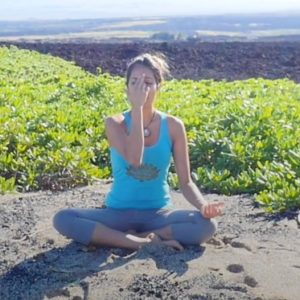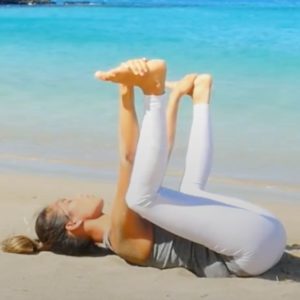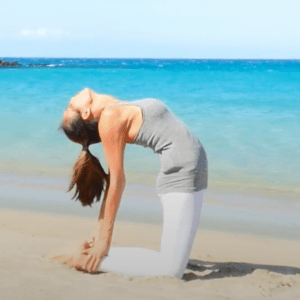Today’s Poses: Upward-Facing Dog and Upward Salute Poses
Upward-Facing Dog and Upward Salute Pose
Upward-Facing Dog and Upward Salute Poses stretch the back and relieve the body of lower backache. Try these poses with Guided Yoga series from YouVeda.
Upward Facing Dog
The upward-facing dog is a back-bending yoga posture that strengthens the arms, wrists, and spine. It also stretches the back and relieves the body of lower backache.
Steps
- Lie flat on your belly with the top of your feet facing downwards. Your arms should be stretched down the length of the body.
- Bend your elbows and spread your palms beside the lowest rib.
- As you inhale, press your palms firmly on the mat and slowly lift your torso, hips, and knees off the mat. The entire weight of the body should be resting on the palms and top of the feet.
- You may look straight ahead or tilt your head slightly backward.
- Ensure that your wrists are in line with your shoulders and the neck is not strained.
- Stay in this pose for a couple of breaths.
- As you exhale, slowly lower your knees, hips, and torso back on the mat.
Benefits
- Stretches and strengthens the back, thus relieving the body of lower backache.
- Most of the bodyweight is borne by the arms and wrists, thus strengthening them.
- This yoga pose helps improve body posture and also stimulates the abdominal organs.
Upward Salute
Upward Salute is a natural way to stretch the whole body, often done automatically after sleeping or sitting for long periods. Standing up and reaching the arms overhead awakens the body from toes to fingertips, providing a boost of energy. It’s a simple way to feel rejuvenated!
Steps
- Begin standing with your feet together and your arms at your sides. Press your weight evenly across the balls and arches of your feet. If you have trouble balancing, stand with your feet six inches apart (or wider).
- Drawdown through your heels and straighten your legs. Press down across all four corners of both feet. Then, lift your ankles and the arches of your feet. Squeeze your outer shins toward each other.
- Engage your quadriceps, drawing the tops of your thighs up and back. Rotate your thighs slightly inward, widening your sit bones.
- Tuck your tailbone slightly, without rounding your lower back. Bring your pelvis to its neutral position and keep your hips even with the centerline of your body. Slightly draw your belly in.
- Broaden across your collarbones. Elongate your neck. Release your shoulder blades away from your head and toward the back of your waist.
- Your ears, shoulders, hips, and ankles should all be in one line. Turn your arms so your palms face forward, fingers reaching toward the floor. This is Tadasana.
- As you inhale, sweep your arms out to the side and then up overhead, turning your arms so your palms face each other, fingertips reaching toward the ceiling. Straighten your arms completely, but do not lock the elbow joints.
- If your shoulders are tight, keep your arms as wide as your shoulders (or even wider). If you can keep your arms straight without drawing your shoulders up, press your palms together.
- Soften the tops of your shoulders away from your ears. Relax your shoulder blades down your back, toward your waist. Draw your lower, front ribs in — do not let these ribs push forward. Lengthen your tailbone toward the floor. Keep your collarbones wide.
- Tilt your head back gently and gaze up at your thumbs.
- Maintain the alignment of Ears, shoulders, hips, and ankles in one line.
- Breathe smoothly and deeply. Imagine your breath is moving across the entire length of your body. Lift up through the sides of your waist as you inhale. Soften your shoulders as you exhale.
- Hold the pose for up to one minute. To release, exhale, and sweep the arms back down to the sides of the body.
Benefits
- It stretches the sides of the body, spine, shoulders, armpits, and belly.
- It tones the thighs, improves digestion, and helps to relieve anxiety and fatigue.
- It also helps to create space in the chest and lungs, which is therapeutic for asthma and congestion.
- This helps to protect the spinal muscles and nerves during other movements.




